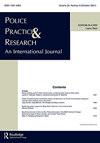描述警察服务呼叫的规模和组成:使用开放数据的复制和扩展
IF 1.8
Q2 CRIMINOLOGY & PENOLOGY
引用次数: 2
摘要
摘要:本文描述了美国底特律警察服务应急需求的规模和构成。其贡献在于复制和扩展美国其他地方报告的分析。调查结果表明,警察花费相当大比例的时间履行社会服务职能。在响应911呼叫的总部署时间中,只有51%用于处理犯罪事件。其余部分用于生活质量(16%)、交通(15%)、健康(7%)、社区(5%)和主动(4%)职责。少数事件消耗了警察不成比例的大量时间。紧急需求集中在时间和空间上,不同类型的需求可能不同。研究结果进一步强调了彻底改革美国警察部队的潜在影响。这里使用的数据和代码是公开的,可以复制、重用和审查。本文章由计算机程序翻译,如有差异,请以英文原文为准。
Describing the scale and composition of calls for police service: a replication and extension using open data
ABSTRACT This paper describes the scale and composition of emergency demand for police services in Detroit, United States. The contribution is made in replication and extension of analyses reported elsewhere in the United States. Findings indicate that police spend a considerable proportion of time performing a social service function. Just 51% of the total deployed time responding to 911 calls is consumed by crime incidents. The remainder is spent on quality of life (16%), traffic (15%), health (7%), community (5%), and proactive (4%) duties. A small number of incidents consume a disproportionately large amount of police officer time. Emergency demand is concentrated in time and space, and can differ between types of demand. The findings further highlight the potential implications of radically reforming police forces in the United States. The data and code used here are openly available for reproduction, reuse, and scrutiny.
求助全文
通过发布文献求助,成功后即可免费获取论文全文。
去求助
来源期刊

Police Practice and Research
CRIMINOLOGY & PENOLOGY-
CiteScore
4.10
自引率
5.60%
发文量
50
期刊介绍:
Police Practice and Research is a peer-reviewed journal that presents current and innovative police research as well as operational and administrative practices from around the world. Articles and reports are sought from practitioners, researchers and others interested in developments in policing, analysis of public order, and the state of safety as it affects the quality of life everywhere. Police Practice and Research seeks to bridge the gap in knowledge that exists regarding who the police are, what they do, and how they maintain order, administer laws, and serve their communities. Attention will also be focused on specific organizational information about the police in different countries or regions. There will be periodic special issues devoted to a particular country or continent.
 求助内容:
求助内容: 应助结果提醒方式:
应助结果提醒方式:


